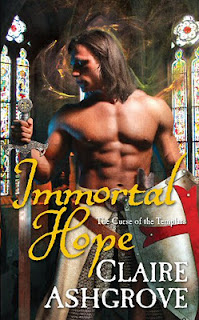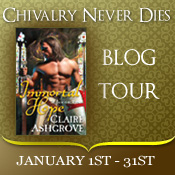Today I have a special guest for you guys. Claire Ashgrove aka Tori St. Claire was my release day mate with Berkley Heat. But instead of just debuting one book like me, she had TWO books release on the SAME DAY under different names and at different publishers. And I thought I was tired. Whew!
So I'm so happy that she was able to take some time and stop by the blog to talk to us about weaving in subplots. Hope you enjoy!
Developing A Sub-plot
by Claire Ashgrove/Tori St. Claire
Hi, everyone! I’d like to thank Roni first, for inviting me here today. She’s my release-date-twin with Berkley Heat (for my erotic romantic suspense as Tori St. Claire, STRIPPED ) and since discovering that, I’ve begun following her blog, learned some wonderful tips, and find myself concurring with a large majority of what she writes. She’s someone to learn from, and I’m thrilled to be stopping in to say hello to all of you.
) and since discovering that, I’ve begun following her blog, learned some wonderful tips, and find myself concurring with a large majority of what she writes. She’s someone to learn from, and I’m thrilled to be stopping in to say hello to all of you.
While I do share a release-date with Roni for STRIPPED, today I want to talk about subplots, and my paranormal romance IMMORTAL HOPE , that also released on January 3.
, that also released on January 3.
If you’ve ever read my Inherited Damnation series, you’ll find I am fascinated by subplots. Not just fascinated, truly addicted. The deeper, more layered, more intricate, the more I love them.
So how does an author layer an effective subplot?
Well, in truth, it’s not easy. And the more you like to subplot, the more difficult it can become. (My newest proposal required a concept understanding of ten—yes ten!—books to get from point A to point Z) Add in that sometimes layering subplot requires deviating from what’s taught as ‘accepted craft’, and then there’s more hurdles for an author to overcome.
But it can be done. The trick is to consider the story you want to tell as a separate story from the one you have to tell.
Huh?
Yes, well, consider this: You’re writing romance. The story you have to tell is a romantic journey between the hero and heroine, internal and external conflict there, and a happily ever after ending. The story you want to tell is all the stuff going on around them that leads you (likely) to a second, third, even tenth book. It’s the stuff that affects the world they are in.
If you break them out by separate stories, then you can evaluate the beginning, middle, and end of each. You can decipher your ongoing conflict, your climax, your resolution for each. Then, you are able to overlay the story you have to tell (Story A) onto the story you want to tell (Story B).
Once they are overlaid, you can look at the major plot points of Story B, and manipulate them so that they become external conflict points in Story A. You may have a resolution to Story A, but as your overlay will depict, you have a lot more to tell with Story B, which is where your next book picks up. The romantic journey for the hero and heroine influence the overall conflict of your main plot, and become goals that must be accomplished for the overall resolution.
I did this with IMMORTAL HOPE, the first book in The Curse of the Templars series.
CENTURIES AGO,
Templar knights defied the archangels and unearthed the copper scroll, revealing the gates to hell. Cursed for their forbidden act, they forever roam the earth protecting mankind from evil. But darkness stalks them, and battles they fight bring them ever-closer to eternal damnation. One promise remains to give them salvation – the return of the seraphs.
Embittered by his purpose, Merrick du Loire must honor an ancient pact and bring peace to his cousin’s soul. When he stumbles upon history professor Anne MacPherson, he discovers she possesses a sacred artifact that marks her as a seraph. Duty demands he set aside his personal quest and locate the knight she’s fated to heal. As he struggles with conflicting oaths, Anne arouses buried hope and sparks forbidden desire that challenges everything he’s sworn to uphold.
Anne has six weeks to complete her thesis on the Knights Templar. When Merrick takes her to the Templar stronghold, he presents her with all she needs—and awakens a soul-deep ache, he alone can soothe. Yet loving Merrick comes with a price. If she admits she's destined for him, her gift of foresight predicts his death.
In this, Story B – the one I wanted to tell – was Azazel’s quest for the relics that would give him the power to overthrow the Almighty. He needs eight to accomplish the vile deed, which provided a set of steps necessary to accomplish his goal. He’s my main character. His antagonists are my protagonists in my individual books. So that story involved developing what he needs, how he’s going to either get them or fail, and what happens as a result of each step. Who will oppose him, how they will oppose him, and whether those persons live or die.
Story A – the story I had to tell – was the romance between Merrick du Loire and Anne MacPherson. To be a romance, we had to have the specific elements required by the genre: boy meets girl, sexual tension, boy gets girl, dark moment where boy loses girl, and then the resolution and HEA.
What keeps them apart are the same things that work towards Azazel’s goal. Immortal Hope covers a small portion of time in Story B, as opposed to trying to stuff it all into the same plot. By using this approach, an author can take time to build necessary world elements, lay the foundation, ground the reader, and extend the life of an idea.
covers a small portion of time in Story B, as opposed to trying to stuff it all into the same plot. By using this approach, an author can take time to build necessary world elements, lay the foundation, ground the reader, and extend the life of an idea.
The result was the series concept:
In 1119, nine knights rode with Hughes de Payens to the Holy Land, becoming the Knights Templar. All were bound by marriage or by blood. Eight were recorded over time. The ninth vanished into history.
Beneath the legendary Temple Mount, the knights uncovered holy relics, including the Copper Scroll—a document written by Azazel’s unholy hand. For their forbidden digging, the archangels exacted a sacrifice. The knights would spend eternity battling the demons of Azazel’s creation, but with each vile death they claimed, a portion of darkness would enter their soul. In time, they would transform into knights of Azazel, warriors veined with evil, destined to fight against the Almighty.
Yet an ancient prophecy remained to give them hope. When darkness raped the land, the seraphs would return. Female descendants of the Nephilim would carry the light to heal their dying souls.
Centuries have passed. Azazel’s might grows to intolerable limits. With the acquisition of eight holy relics, he will gain the power to overthrow the Almighty.
Six Templars stand above the rest in duty, honor, and loyalty. But each is haunted by a tragic past, and their darkened souls rapidly near the end. As they battle both the overwhelming power of evil and the nightmares of lives they left behind, the seraphs are more than tools to victory.
They are salvation.
Overlaying two separate stories is only one approach to sub-plotting, but I feel it’s the easiest place to start, and the most basic to explain. There are dozens of methods, dozens of charts out there to help an author track. The most important thing to remember? If you treat a subplot like its own individual book, the stronger and more engaging it will become, and the more room for later opportunity you develop.
Good luck with your writing in 2012! If there’s ever a question about writing you’d like to ask me, feel free to drop me an email anytime.
~Claire
Claire will be giving away a $25 Amazon.com gift certificate to one randomly drawn commenter during the tour, and a second $25.00 Amazon.com gift certificate to a second randomly drawn commenter at the end of the tour. Be sure to follow the tour and comment; the more you comment, the better your chances of winning! Click the Blog Tour badge for a complete list of blog stops.
"Hot and romantic, with an edge of suspense that will keep you entertained.” --Shayla Black, New York Times Bestselling author of SURRENDER TO ME
CRASH INTO YOU is now available!
Read an excerpt here.
All content copyright of the author. Please ask permission before re-printing or re-posting. Fair use quotations and links do no require prior consent of the author. ©Roni Loren 2009-2012 |Copyright Statement|

